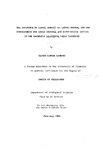THE INFLUENCE OF LARVAL DENSITY ON LARVAL GROWTH, AND THE CONSEQUENCES FOR ADULT SURVIVAL AND REPRODUCTIVE SUCCESS IN THE DAMSELFLY CALOPTERYX VIRGO (ODONATA)
| dc.contributor.author | LAMBERT, CLAIRE LOUISE | |
| dc.contributor.other | School of Biological and Marine Sciences | en_US |
| dc.date.accessioned | 2013-10-22T10:22:40Z | |
| dc.date.available | 2013-10-22T10:22:40Z | |
| dc.date.issued | 1994 | |
| dc.identifier | NOT AVAILABLE | en_US |
| dc.identifier.uri | http://hdl.handle.net/10026.1/2279 | |
| dc.description.abstract |
This study of a population of C.virgo at Burrator, Dartmoor looks for signs of a population regulation mechanism acting through the effects of larval density on larval growth. The consequences of adult body size and emergence time for survival and reproductive success are also examined to look for further regulation mechanisms, and opportunities for natural and sexual selection; in particular the importance of body size to territorial males. Although there were significant differences in patterns of growth and body size within and between year classes of larvae, the differences were were not related to density. Smaller, later developing larvae were present, and the possibility that this was related to late hatching is discussed. Smaller, later developing larvae emerged later as smaller sized adults. Survival to maturity was not influenced by body size. Density-triggered bird predation was a regular feature of the population, and could result in early emergers experiencing higher survival to maturity. The advantage of early emergence could, however, easily be countered by adverse weather patterns. A field experiment showed that ovipositing females were highly aggregated, and that mature males were able to predict and profit from the aggregated distribution of females. Consequently male daily reproductive success was very variable, and was by far the most important component of their lifetime reproductive success. A large body size was an advantage to mature males when levels of competition were high, but not when competition was reduced as a result of bird predation and poor weather. Mature females produced between 85 and 1,615 eggs in their lifetime. The number of sunny days females survived to see was the most important component of their lifetime reproductive success, and was influenced by random predation and weather patterns. Body size was not related to either survival or clutch size. Early emerging females had higher lifetime reproductive success, but only as a result of the timing of the density-triggered bird predation, and this advantage could easily be lost through random weather patterns. The lack of evidence for density dependent feeding competition in larvae, and for a relationship between female body size and fecundity in adults, suggests that feeding competition is not a regulatory mechanism in this population. The difficulties of detecting density dependence in short term studies is discussed. The strong influence of environmental variables on the importance of adult body size and emergence time indicates that the opportunity for selection of these characteristics would be variable and hence weak in the short term. Over the long term, however, there would be a persistent selective pressure, and the possible consequences for larval growth are discussed. | en_US |
| dc.description.sponsorship | Devon Wildlife Trust | en_US |
| dc.language.iso | en | en_US |
| dc.publisher | University of Plymouth | en_US |
| dc.title | THE INFLUENCE OF LARVAL DENSITY ON LARVAL GROWTH, AND THE CONSEQUENCES FOR ADULT SURVIVAL AND REPRODUCTIVE SUCCESS IN THE DAMSELFLY CALOPTERYX VIRGO (ODONATA) | en_US |
| dc.type | Thesis | |
| dc.identifier.doi | http://dx.doi.org/10.24382/4163 | |
| dc.identifier.doi | http://dx.doi.org/10.24382/4163 |
Files in this item
This item appears in the following Collection(s)
-
01 Research Theses Main Collection
Research Theses Main


